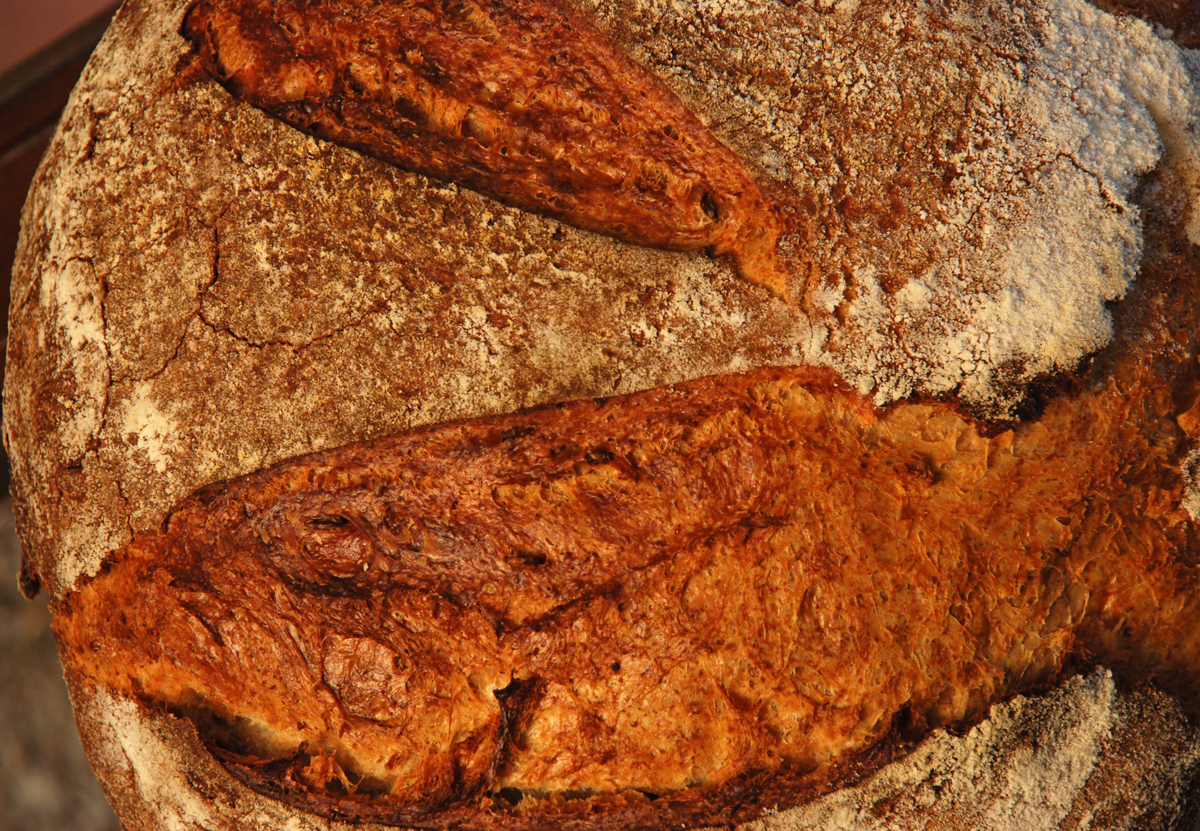
I based this recipe loosely on an old yeast based recipe I had created many years ago which always came out nice and light and moist. I wanted to make a nice light and airy sourdough loaf using whipped egg whites and cream cheese for a nice flavorful texture. I like to think my bread making is much more sophisticated now than 15 years ago when I first made this recipe. Back then I was not into sourdough yet and had just graduated from the bread maker to a Kitchen Aid stand mixer. Now, I prefer bread that has layers of flavor and a nice chewy crust.
In order to accomplish my goal of a light and airy bread but with a nice crust and layers of flavor I used wheat germ, malted wheat flakes and oat flour to give the finished product a nice nutty flavor. I used a combination of French style flour and European style flour from KAF along with some white rye and potato flour as well as some raspberry balsamic vinegar.
I have to say the end result was exactly what I was hoping for and more. The crust is perfect with a nice airy open crumb and the taste is nice and nutty but light. The malted wheat flakes add a nice element in the crumb as well.
This is a perfect bread for just about anything so I hope you give it a try.
I used my standard 65% AP starter for this recipe.
Directions
AP Starter
227 grams AP Flour
71 grams AP Seed Starter
151 grams Water at Room Temperature (80-90 degrees F.)
Mix ingredients in a bowl until thoroughly combined. Cover the bowl and let it sit at room temperature for around 8 hours. The starter should almost double when ready to proceed. You can either mix in final dough or put in refrigerator for at most 1 day before using. If your kitchen is warmer than mine which is usually about 70-72 degrees with my air-conditioning you can proceed sooner.
Main Dough Ingredients
425 grams Refreshed AP Starter (65% hydration) from above
150 grams European Style Flour (KAF, you can substitute bread flour with a little whole wheat mixed in)
50 grams Wheat Germ
200 grams French Style Flour (KAF, you can substitute AP flour if necessary)
50 grams Oat Flour (KAF)
50 grams White Rye Flour (KAF)
65 grams Potato Flour
40 grams Malted Wheat Flakes
224 grams Softened Cream Cheese (1 Package)
132 grams Egg Whites (4 large eggs)
25 grams Raspberry Balsamic Vinegar
16 grams Seas Salt or Table Salt
343 grams Water at Room Temperature
Procedure
In the bowl of your mixer using your beater attachment whip the egg whites on the highest speed until stiff peaks are formed. Set aside while you mix the main dough below.
Mix the flours, and malted wheat flakes and wheat germ with the water in your mixer or by hand for 1 minute. Next fold in the egg whites by hand and let it rest covered in your bowl for 20-30 minutes. Next cut the starter into small pieces and add to the flour mixture in the bowl and also add the oil, salt, cream cheese and vinegar. Mix for 4 minute to incorporate all the ingredients. I mixed on speed #1 for 3 minutes and speed #2 for 1 minutes. Note this is a very wet dough but resist the urge to add too much flour as you don't want the dough to become too stiff.
Next take the dough out of the bowl and place it in an oiled bowl or container. Do a stretch and fold and rest the dough uncovered for 20 minutes. After the rest do another stretch and fold and cover the dough and let it rest for 10 minutes. Do one more stretch and fold and put the dough into a lightly oiled bowl and let it sit at room temperature covered for 2 hours (if it is already in a bowl just make sure to cover it). (Note: since this dough is very wet, I did 2 extra stretch and folds in the bold and one additional one right before putting it in the refrigerator). After 2 hours you can put the dough into the refrigerator for 24 hours or up to 2 days before baking. I baked the bread about 24 hours later.
The next day (or when ready to bake) let the dough sit out at room temperature for 2 hours.
Next, form the dough into your desired shape and put them in floured bannetons, bowls or on a baking sheet and let them rise covered for 2 hours or until they pass the poke test. Just make sure to not let them over-rise.
I made one large boule and used a basket with a floured linen liner.


When read to bake, score the loaf as desired and prepare your oven for baking with steam.
Set your oven for 500 degrees F. at least 45 minutes before ready to bake. When ready to bake place the loaves into your on your oven stone with steam and lower the temperature immediately to 450 degrees. When both loaves are golden brown and reached an internal temperature of 200 degrees F. you can remove them from the oven. Since this was one large loaf it took about 55 minutes to bake. (Note: since I made one large Miche I had to lower the temperature to around 425 degrees F. with about 20 minutes to go so the crust would not get too dark).
Let the loaves cool down for at least an 3 hours or so before eating as desired.

-